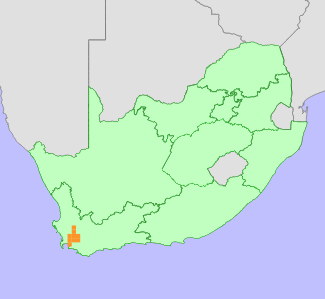|
Scientific Name | Protea scorzonerifolia (Salisb. ex Knight) Rycroft |
Higher Classification | Dicotyledons |
Family | PROTEACEAE |
Common Names | Channel-leaf Sugarbush (e) |
National Status |
Status and Criteria | Vulnerable A2ce |
Assessment Date | 2020/06/05 |
Assessor(s) | A.G. Rebelo, H. Mtshali & L. von Staden |
Justification | Protea scorzonerifolia has experienced a population reduction of at least 30% over the past three generations (generation length 50-100 years) due to habitat loss from urban expansion, agricultural development and afforestation. It continues to be threatened by alien plant invasion and is therefore listed as Vulnerable under criterion A. |
Distribution |
Endemism | South African endemic |
Provincial distribution | Western Cape |
Range | This species is endemic to upper Breede River Valley and also occurs from Du Toit's Kloof to Hottentots-Holland Mountains. It is extinct on the Cape Peninsula. |
Habitat and Ecology |
Major system | Terrestrial |
Major habitats | South Hex Sandstone Fynbos, Hawequas Sandstone Fynbos, Elgin Shale Fynbos, Cape Winelands Shale Fynbos, Breede Shale Fynbos, Boland Granite Fynbos, Central Coastal Shale Band Vegetation, Western Coastal Shale Band Vegetation, Northern Inland Shale Band Vegetation, Swartland Alluvium Fynbos, Breede Alluvium Fynbos |
Description | It is confined to remnants of granite and shale soils on upper remaining slopes, but also occurs on sandstone where there are traces of clay soils. It is a long-lived species, and survives fires by resprouting from underground stems. Wind-dispersed seeds are stored in fire-resistant inflorescences, and released after fires. It is pollinated by birds. |
Threats |
| About 32% of this species' habitat is already irreversibly modified, predominantly due to historical habitat loss to agricultural expansion on lowland alluvial soils in the Breede River Valley, and timber plantations on the lower slopes of the Hottentots-Holland, Wemmershoek, Du Toit's Kloof and Franschhoek mountains. Timber plantations are however no longer expanding and this threat has ceased. There is slow, ongoing habitat loss, but since the majority of this species' habitat is in montane areas unsuited to cultivation, overall habitat loss has dropped to 2% in the past 24 years.
Subpopulations on slopes above plantations are currently threatened by rapidly spreading escaped pine seedlings, which are already outcompeting native species around Franschhoek Pass and at Wemmershoek. Spreading, unmanaged alien invasive pines, acacia and hakea are also a threat to subpopulations in other parts of its range. |
Population |
Protea scorzonerifolia is locally common and sparsely distributed. Presumably it was historically far more abundant on lower slopes, but most of the lower extant subpopulations are now isolated and small. It is known from 43 subpopulations that continue to decline due to competition from alien invasive plants. A population reduction of 26-34% is inferred from habitat loss over the past three generations. If recent rates of habitat loss are projected into the future, population reduction could possibly exceed 40% within three generations, as this is a very long-lived species. Most of its remaining habitat is however in montane areas where the rate of loss is significantly lower than in the lowlands, and projected population reduction is very uncertain as most of its habitat is now protected.
The species presumably went extinct on the Peninsula due to urban developments. This loss is not considered in determining the current status as it probably occurred more than 150 years ago (3 generations).
|
Population trend | Decreasing |
Conservation |
| This species is conserved at Haweqwa, Mont Rochelle and Waterval nature reserves. Ex situ collections are held at Kirstenbosch Botanical Gardens. |
Assessment History |
Taxon assessed |
Status and Criteria |
Citation/Red List version | | Protea scorzonerifolia (Salisb. ex Knight) Rycroft | VU A2c | Raimondo et al. (2009) | | Protea scorzonerifolia (Salisb. ex Knight) Rycroft | Vulnerable | Hilton-Taylor (1996) | |
Bibliography |
Goldblatt, P. and Manning, J.C. 2000. Cape Plants: A conspectus of the Cape Flora of South Africa. Strelitzia 9. National Botanical Institute, Cape Town.
Hilton-Taylor, C. 1996. Red data list of southern African plants. Strelitzia 4. South African National Botanical Institute, Pretoria.
Manning, J.C. and Goldblatt, P. 2012. Plants of the Greater Cape Floristic Region 1: The Core Cape Flora. Strelitzia 29. South African National Biodiversity Institute, Pretoria.
Raimondo, D., von Staden, L., Foden, W., Victor, J.E., Helme, N.A., Turner, R.C., Kamundi, D.A. and Manyama, P.A. 2009. Red List of South African Plants. Strelitzia 25. South African National Biodiversity Institute, Pretoria.
Rebelo, T. 2001. Sasol Proteas: A field guide to the proteas of southern Africa. (2nd ed.). Fernwood Press, Vlaeberg, Cape Town.
|
Citation |
| Rebelo, A.G., Mtshali, H. & von Staden, L. 2020. Protea scorzonerifolia (Salisb. ex Knight) Rycroft. National Assessment: Red List of South African Plants version 2024.1. Accessed on 2025/10/17 |
 Comment on this assessment
Comment on this assessment

